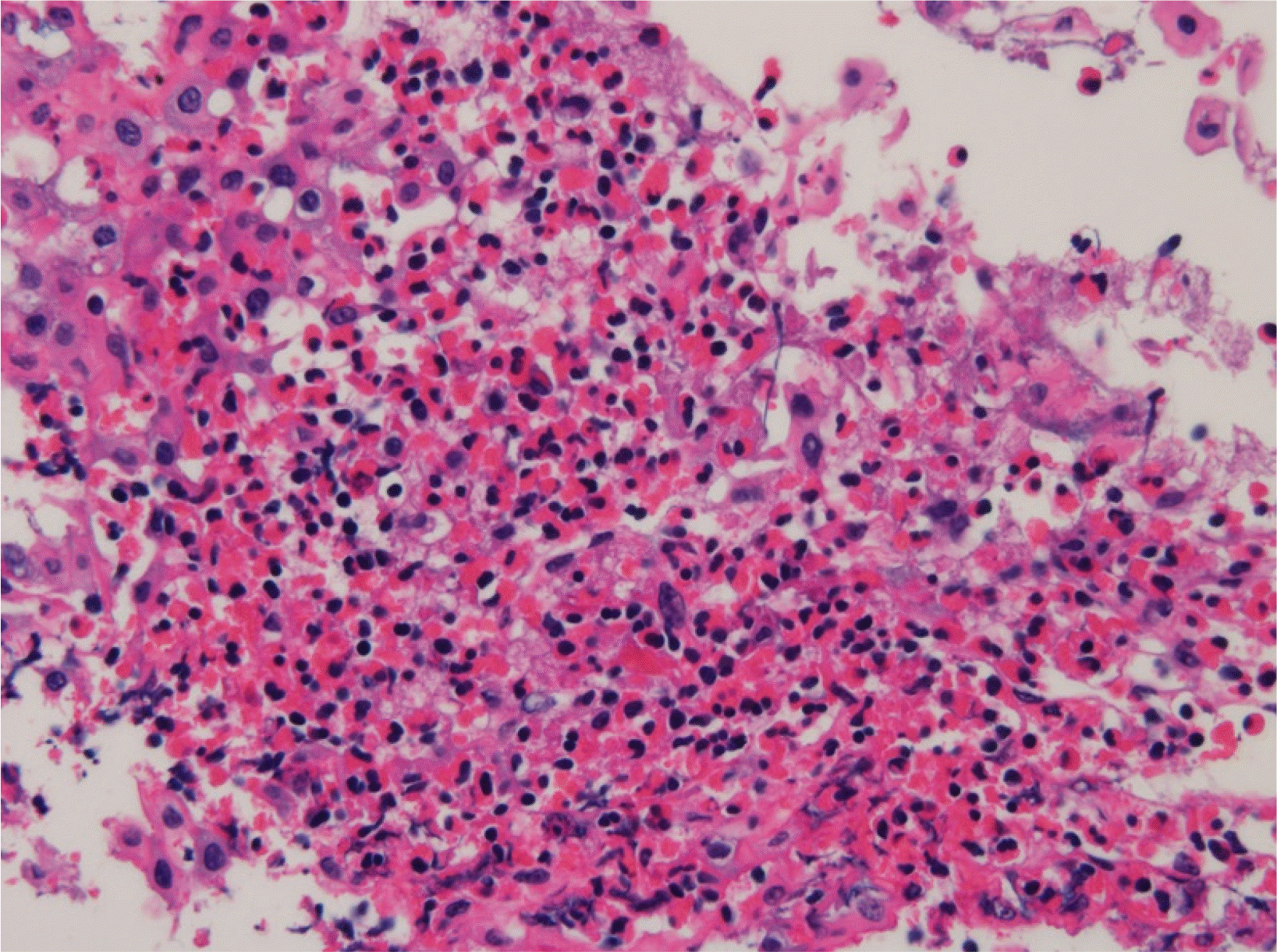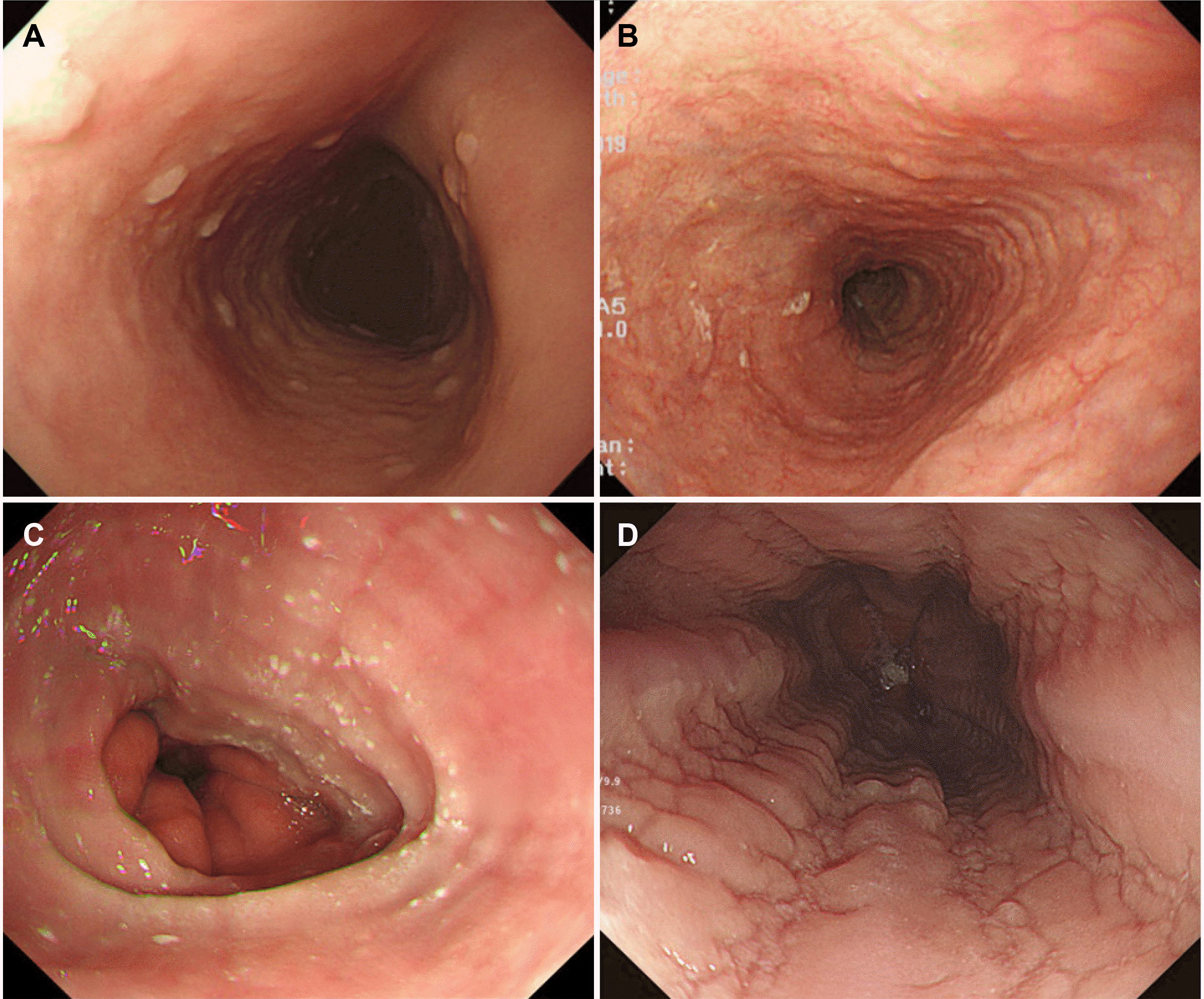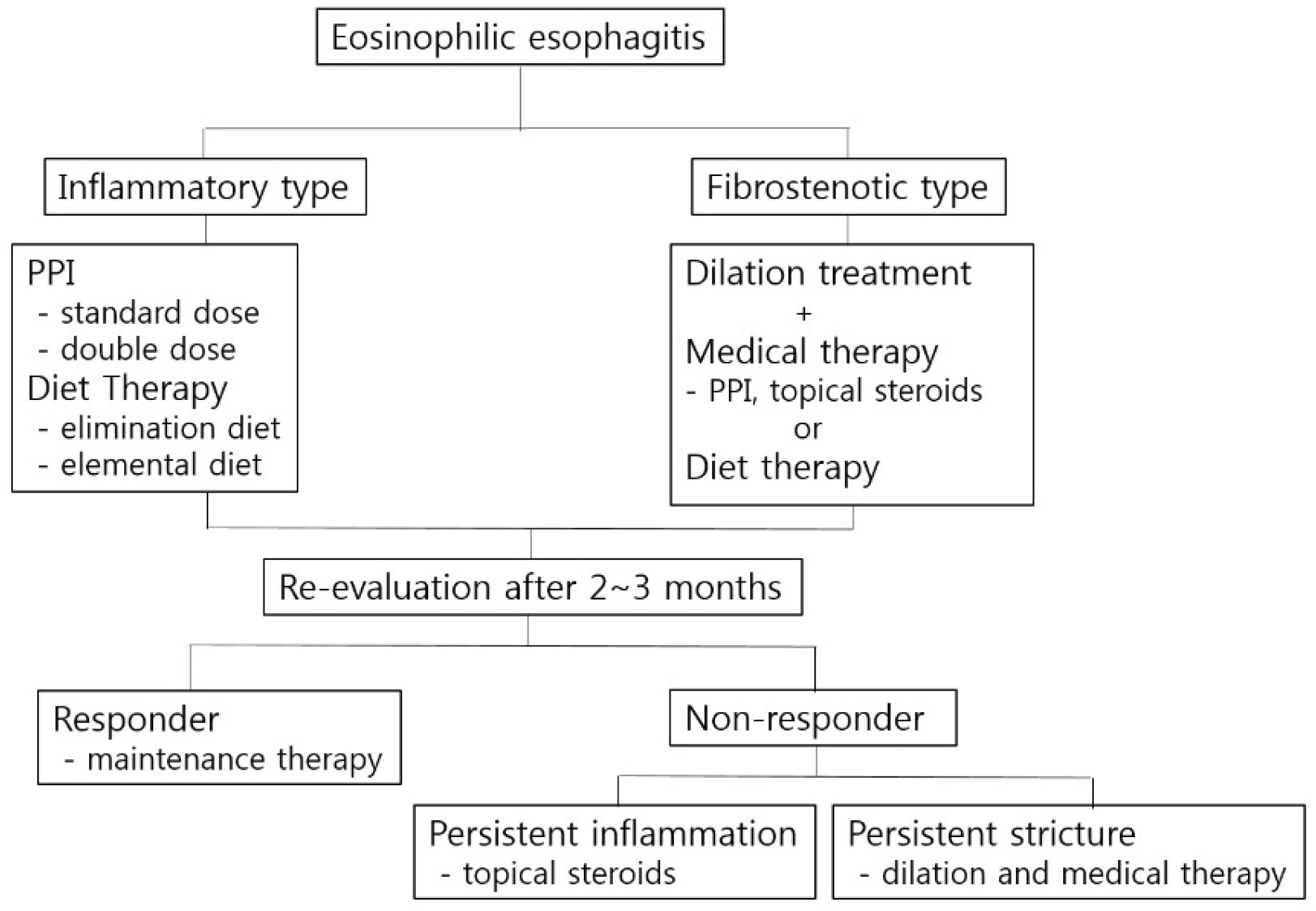1. Holvoet S, Blanchard C. 2014; Genetic and molecular mechanisms leading to eosinophilic esophagitis. Rev Esp Enferm Dig. 106:276–280. PMID:
25075658.
2. Sherrill JD, Rothenberg ME. 2011; Genetic dissection of eosinophilic esophagitis provides insight into disease pathogenesis and treatment strategies. J Allergy Clin Immunol. 128:23–34. DOI:
10.1016/j.jaci.2011.03.046. PMID:
21570716. PMCID:
PMC3129465.

3. Dobbins JW, Sheahan DG, Behar J. 1977; Eosinophilic gastroenteritis with esophageal involvement. Gastroenterology. 72:1312–1316. DOI:
10.1016/S0016-5085(77)80034-6. PMID:
870380.

4. Landres RT, Kuster GG, Strum WB. 1978; Eosinophilic esophagitis in a patient with vigorous achalasia. Gastroenterology. 74:1298–1301. DOI:
10.1016/0016-5085(78)90710-2. PMID:
648822.

5. Attwood SE, Smyrk TC, Demeester TR, Jones JB. 1993; Esophageal eosinophilia with dysphagia. A distinct clinicopathologic syndrome. Dig Dis Sci. 38:109–116. DOI:
10.1007/BF01296781. PMID:
8420741.
6. Kelly KJ, Lazenby AJ, Rowe PC, Yardley JH, Perman JA, Sampson HA. 1995; Eosinophilic esophagitis attributed to gastroesophageal reflux: improvement with an amino acid-based formula. Gastroenterology. 109:1503–1512. DOI:
10.1016/0016-5085(95)90637-1. PMID:
7557132.

7. Straumann A, Spichtin HP, Bernoulli R, Loosli J, Vögtlin J. 1994; Idiopathic eosinophilic esophagitis: a frequently overlooked disease with typical clinical aspects and discrete endoscopic findings. Schweiz Med Wochenschr. 124:1419–1429. PMID:
7939509.
9. Kinoshita Y, Ishimura N, Oshima N, Ishihara S. 2015; Systematic review: eosinophilic esophagitis in Asian countries. World J Gastroenterol. 21:8433–8440. DOI:
10.3748/wjg.v21.i27.8433. PMID:
26217096. PMCID:
PMC4507114.

10. Kim GH, Park YS, Jung KW, et al. 2019; An increasing trend of eosinophilic esophagitis in Korea and the clinical implication of the biomarkers to determine disease activity and treatment response in eosinophilic esophagitis. J Neurogastroenterol Motil. 25:525–533. DOI:
10.5056/jnm19066. PMID:
31587544. PMCID:
PMC6786448.

11. Kim SJ, Park MI, Kim GH, et al. 2021; Practice patterns for eosinophilic esophagitis patients in Busan and Gyeongnam: a Korean multicenter database study. J Neurogastroenterol Motil. 27:71–77. DOI:
10.5056/jnm20069. PMID:
32699187. PMCID:
PMC7786091.

12. Jensen ET, Kappelman MD, Kim HP, Ringel-Kulka T, Dellon ES. 2013; Early life exposures as risk factors for pediatric eosinophilic esophagitis. J Pediatr Gastroenterol Nutr. 57:67–71. DOI:
10.1097/MPG.0b013e318290d15a. PMID:
23518485.

13. van Nimwegen FA, Penders J, Stobberingh EE, et al. 2011; Mode and place of delivery, gastrointestinal microbiota, and their influence on asthma and atopy. J Allergy Clin Immunol. 128:948–955. e553. DOI:
10.1016/j.jaci.2011.07.027. PMID:
21872915.

14. Liacouras CA, Furuta GT, Hirano I, et al. 2011; Eosinophilic esophagitis: updated consensus recommendations for children and adults. J Allergy Clin Immunol. 128:3–22. DOI:
10.1016/j.jaci.2011.02.040. PMID:
21477849.
15. Shah SC, Tepler A, Peek RM Jr, Colombel JF, Hirano I, Narula N. 2019; Association between Helicobacter pylori exposure and decreased odds of eosinophilic esophagitis-a systematic review and meta-analysis. Clin Gastroenterol Hepatol. 17:2185–2198. e3. DOI:
10.1016/j.cgh.2019.01.013. PMID:
30659992. PMCID:
PMC7354099.

17. Hooi JKY, Lai WY, Ng WK, et al. 2017; Global prevalence of Helicobacter pylori infection: systematic review and meta-analysis. Gastroenterology. 153:420–429. DOI:
10.1053/j.gastro.2017.04.022. PMID:
28456631.

18. Molina-Infante J, Gutierrez-Junquera C, Savarino E, et al. 2018; Helicobacter pylori infection does not protect against eosinophilic esophagitis: results from a large multicenter case-control study. Am J Gastroenterol. 113:972–979. DOI:
10.1038/s41395-018-0035-6. PMID:
29545632.

19. Katzka DA. 2014; The complex relationship between eosinophilic esophagitis and gastroesophageal reflux disease. Dig Dis. 32:93–97. DOI:
10.1159/000357080. PMID:
24603388.

20. Kia L, Hirano I. 2015; Distinguishing GERD from eosinophilic oesophagitis: concepts and controversies. Nat Rev Gastroenterol Hepatol. 12:379–386. DOI:
10.1038/nrgastro.2015.75. PMID:
25986303. PMCID:
PMC4948861.

22. Lucendo AJ, De Rezende L, Comas C, Caballero T, Bellón T. 2008; Treatment with topical steroids downregulates IL-5, eotaxin-1/CCL11, and eotaxin-3/CCL26 gene expression in eosinophilic esophagitis. Am J Gastroenterol. 103:2184–2193. DOI:
10.1111/j.1572-0241.2008.01937.x. PMID:
18844613.

23. Blanchard C, Stucke EM, Rodriguez-Jimenez B, et al. 2011; A striking local esophageal cytokine expression profile in eosinophilic esophagitis. J Allergy Clin Immunol. 127:208–217.e2177. DOI:
10.1016/j.jaci.2010.10.039. PMID:
21211656. PMCID:
PMC3027004.
24. Mishra A, Wang M, Pemmaraju VR, et al. 2008; Esophageal remodeling develops as a consequence of tissue specific IL-5-induced eosinophilia. Gastroenterology. 134:204–214. DOI:
10.1053/j.gastro.2007.10.002. PMID:
18166354. PMCID:
PMC2654267.

25. Blanchard C, Wang N, Stringer KF, et al. 2006; Eotaxin-3 and a uniquely conserved gene-expression profile in eosinophilic esophagitis. J Clin Invest. 116:536–547. DOI:
10.1172/JCI26679. PMID:
16453027. PMCID:
PMC1359059.

27. Furuta GT, Liacouras CA, Collins MH, et al. 2007; Eosinophilic esophagitis in children and adults: a systematic review and consensus recommendations for diagnosis and treatment. Gastroenterology. 133:1342–1363. DOI:
10.1053/j.gastro.2007.08.017. PMID:
17919504.

28. Schoepfer AM, Safroneeva E, Bussmann C, et al. 2013; Delay in diagnosis of eosinophilic esophagitis increases risk for stricture formation in a time-dependent manner. Gastroenterology. 145:1230–1236.e62. DOI:
10.1053/j.gastro.2013.08.015. PMID:
23954315.

29. Dellon ES, Kim HP, Sperry SL, Rybnicek DA, Woosley JT, Shaheen NJ. 2014; A phenotypic analysis shows that eosinophilic esophagitis is a progressive fibrostenotic disease. Gastrointest Endosc. 79:577–585.e4. DOI:
10.1016/j.gie.2013.10.027. PMID:
24275329. PMCID:
PMC4599711.

30. Korsapati H, Babaei A, Bhargava V, Dohil R, Quin A, Mittal RK. 2009; Dysfunction of the longitudinal muscles of the oesophagus in eosinophilic oesophagitis. Gut. 58:1056–1062. DOI:
10.1136/gut.2008.168146. PMID:
19136515.

31. Kwiatek MA, Hirano I, Kahrilas PJ, Rothe J, Luger D, Pandolfino JE. 2011; Mechanical properties of the esophagus in eosinophilic esophagitis. Gastroenterology. 140:82–90. DOI:
10.1053/j.gastro.2010.09.037. PMID:
20858491. PMCID:
PMC3008315.

32. Francis DL, Foxx-Orenstein A, Arora AS, et al. 2012; Results of ambulatory pH monitoring do not reliably predict response to therapy in patients with eosinophilic oesophagitis. Aliment Pharmacol Ther. 35:300–307. DOI:
10.1111/j.1365-2036.2011.04922.x. PMID:
22111863.

34. Dellon ES, Liacouras CA, Molina-Infante J, et al. 2018; Updated international consensus diagnostic criteria for eosinophilic esophagitis: proceedings of the AGREE conference. Gastroenterology. 155:1022–1033.e10. DOI:
10.1053/j.gastro.2018.07.009. PMID:
30009819. PMCID:
PMC6174113.
35. Dellon ES, Gonsalves N, Hirano I, et al. 2013; ACG clinical guideline: evidenced based approach to the diagnosis and management of esophageal eosinophilia and eosinophilic esophagitis (EoE). Am J Gastroenterol. 108:679–693. DOI:
10.1038/ajg.2013.71. PMID:
23567357.

36. Lucendo AJ, Molina-Infante J, Arias Á, et al. 2017; Guidelines on eosinophilic esophagitis: evidence-based statements and recommendations for diagnosis and management in children and adults. United European Gastroenterol J. 5:335–358. DOI:
10.1177/2050640616689525. PMID:
28507746. PMCID:
PMC5415218.

37. Dellon ES, Speck O, Woodward K, et al. 2013; Clinical and endoscopic characteristics do not reliably differentiate PPI-responsive esophageal eosinophilia and eosinophilic esophagitis in patients undergoing upper endoscopy: a prospective cohort study. Am J Gastroenterol. 108:1854–1860. DOI:
10.1038/ajg.2013.363. PMID:
24145677. PMCID:
PMC4574875.

38. Warners MJ, van Rhijn BD, Curvers WL, Smout AJ, Bredenoord AJ. 2015; PPI-responsive esophageal eosinophilia cannot be distinguished from eosinophilic esophagitis by endoscopic signs. Eur J Gastroenterol Hepatol. 27:506–511. DOI:
10.1097/MEG.0000000000000331. PMID:
25822858.

39. Moawad FJ, Veerappan GR, Dias JA, Baker TP, Maydonovitch CL, Wong RK. 2013; Randomized controlled trial comparing aerosolized swallowed fluticasone to esomeprazole for esophageal eosinophilia. Am J Gastroenterol. 108:366–372. DOI:
10.1038/ajg.2012.443. PMID:
23399553.

40. Dellon ES, Speck O, Woodward K, et al. 2014; Markers of eosinophilic inflammation for diagnosis of eosinophilic esophagitis and proton pump inhibitor-responsive esophageal eosinophilia: a prospective study. Clin Gastroenterol Hepatol. 12:2015–2022. DOI:
10.1016/j.cgh.2014.06.019. PMID:
24993367. PMCID:
PMC4252508.

41. Shoda T, Matsuda A, Nomura I, et al. 2017; Eosinophilic esophagitis versus proton pump inhibitor-responsive esophageal eosinophilia: transcriptome analysis. J Allergy Clin Immunol. 139:2010–2013.e4. DOI:
10.1016/j.jaci.2016.11.028. PMID:
28063872.

42. Cheng E, Zhang X, Huo X, et al. 2013; Omeprazole blocks eotaxin-3 expression by oesophageal squamous cells from patients with eosinophilic oesophagitis and GORD. Gut. 62:824–832. DOI:
10.1136/gutjnl-2012-302250. PMID:
22580413. PMCID:
PMC3552049.

43. van Rhijn BD, Weijenborg PW, Verheij J, et al. 2014; Proton pump inhibitors partially restore mucosal integrity in patients with proton pump inhibitor-responsive esophageal eosinophilia but not eosinophilic esophagitis. Clin Gastroenterol Hepatol. 12:1815–1823.e2. DOI:
10.1016/j.cgh.2014.02.037. PMID:
24657840.

44. Hirano I, Moy N, Heckman MG, Thomas CS, Gonsalves N, Achem SR. 2013; Endoscopic assessment of the oesophageal features of eosinophilic oesophagitis: validation of a novel classification and grading system. Gut. 62:489–495. DOI:
10.1136/gutjnl-2011-301817. PMID:
22619364.

45. Kim HP, Vance RB, Shaheen NJ, Dellon ES. 2012; The prevalence and diagnostic utility of endoscopic features of eosinophilic esophagitis: a meta-analysis. Clin Gastroenterol Hepatol. 10:988–996.e5. DOI:
10.1016/j.cgh.2012.04.019. PMID:
22610003. PMCID:
PMC3424367.

46. van Rhijn BD, Warners MJ, Curvers WL, et al. 2014; Evaluating the endoscopic reference score for eosinophilic esophagitis: moderate to substantial intra- and interobserver reliability. Endoscopy. 46:1049–1055. DOI:
10.1055/s-0034-1377781. PMID:
25208033.

47. Dellon ES, Cotton CC, Gebhart JH, et al. 2016; Accuracy of the eosinophilic esophagitis Endoscopic Reference Score in diagnosis and determining response to treatment. Clin Gastroenterol Hepatol. 14:31–39. DOI:
10.1016/j.cgh.2015.08.040. PMID:
26404868. PMCID:
PMC4690779.

48. van Rhijn BD, Verheij J, Smout AJ, Bredenoord AJ. 2016; The Endoscopic Reference Score shows modest accuracy to predict histologic remission in adult patients with eosinophilic esophagitis. Neurogastroenterol Motil. 28:1714–1722. DOI:
10.1111/nmo.12872. PMID:
27254480.

49. Prasad GA, Talley NJ, Romero Y, et al. 2007; Prevalence and predictive factors of eosinophilic esophagitis in patients presenting with dysphagia: a prospective study. Am J Gastroenterol. 102:2627–2632. DOI:
10.1111/j.1572-0241.2007.01512.x. PMID:
17764492.

50. Gonsalves N, Policarpio-Nicolas M, Zhang Q, Rao MS, Hirano I. 2006; Histopathologic variability and endoscopic correlates in adults with eosinophilic esophagitis. Gastrointest Endosc. 64:313–319. DOI:
10.1016/j.gie.2006.04.037. PMID:
16923475.

51. Shah A, Kagalwalla AF, Gonsalves N, Melin-Aldana H, Li BU, Hirano I. 2009; Histopathologic variability in children with eosinophilic esophagitis. Am J Gastroenterol. 104:716–721. DOI:
10.1038/ajg.2008.117. PMID:
19209168.

52. Nielsen JA, Lager DJ, Lewin M, Rendon G, Roberts CA. 2014; The optimal number of biopsy fragments to establish a morphologic diagnosis of eosinophilic esophagitis. Am J Gastroenterol. 109:515–520. DOI:
10.1038/ajg.2013.463. PMID:
24445569.

53. Abe Y, Sasaki Y, Yagi M, Yaoita T, Nishise S, Ueno Y. 2017; Diagnosis and treatment of eosinophilic esophagitis in clinical practice. Clin J Gastroenterol. 10:87–102. DOI:
10.1007/s12328-017-0725-4. PMID:
28247277.

54. Mueller S, Neureiter D, Aigner T, Stolte M. 2008; Comparison of histological parameters for the diagnosis of eosinophilic oesophagitis versus gastro-oesophageal reflux disease on oesophageal biopsy material. Histopathology. 53:676–684. DOI:
10.1111/j.1365-2559.2008.03187.x. PMID:
19076684.

55. Odze RD. 2009; Pathology of eosinophilic esophagitis: what the clinician needs to know. Am J Gastroenterol. 104:485–490. DOI:
10.1038/ajg.2008.40. PMID:
19174804.

56. Kinoshita Y, Furuta K, Ishimaura N, et al. 2013; Clinical characteristics of Japanese patients with eosinophilic esophagitis and eosinophilic gastroenteritis. J Gastroenterol. 48:333–339. DOI:
10.1007/s00535-012-0640-x. PMID:
22847555.

57. Fox VL, Nurko S, Teitelbaum JE, Badizadegan K, Furuta GT. 2003; High-resolution EUS in children with eosinophilic "allergic" esophagitis. Gastrointest Endosc. 57:30–36. DOI:
10.1067/mge.2003.33. PMID:
12518127.

58. Gentile N, Katzka D, Ravi K, et al. 2014; Oesophageal narrowing is common and frequently under-appreciated at endoscopy in patients with oesophageal eosinophilia. Aliment Pharmacol Ther. 40:1333–1340. DOI:
10.1111/apt.12977. PMID:
25287184.

59. Konikoff MR, Blanchard C, Kirby C, et al. 2006; Potential of blood eosinophils, eosinophil-derived neurotoxin, and eotaxin-3 as biomarkers of eosinophilic esophagitis. Clin Gastroenterol Hepatol. 4:1328–1336. DOI:
10.1016/j.cgh.2006.08.013. PMID:
17059896.

60. Nicodème F, Hirano I, Chen J, et al. 2013; Esophageal distensibility as a measure of disease severity in patients with eosinophilic esophagitis. Clin Gastroenterol Hepatol. 11:1101–1107.e1. DOI:
10.1016/j.cgh.2013.03.020. PMID:
23591279. PMCID:
PMC3790569.

62. Straumann A, Conus S, Degen L, et al. 2011; Long-term budesonide maintenance treatment is partially effective for patients with eosinophilic esophagitis. Clin Gastroenterol Hepatol. 9:400–409. e1. DOI:
10.1016/j.cgh.2011.01.017. PMID:
21277394.

63. Hirano I, Chan ES, Rank MA, et al. 2020; AGA Institute and the Joint task force on allergy-immunology practice parameters clinical guidelines for the management of eosinophilic esophagitis. Gastroenterology. 158:1776–1786. DOI:
10.1053/j.gastro.2020.02.038. PMID:
32359562.

64. Gómez-Torrijos E, García-Rodríguez R, Castro-Jiménez A, Rodríguez-Sanchez J, Méndez Díaz Y, Molina-Infante J. 2016; The efficacy of step-down therapy in adult patients with proton pump inhibitor-responsive oesophageal eosinophilia. Aliment Pharmacol Ther. 43:534–540. DOI:
10.1111/apt.13496. PMID:
26662868.

65. Lucendo AJ, Arias Á, Molina-Infante J. 2016; Efficacy of proton pump inhibitor drugs for inducing clinical and histologic remission in patients with symptomatic esophageal eosinophilia: a systematic review and meta-analysis. Clin Gastroenterol Hepatol. 14:13–22.e1. DOI:
10.1016/j.cgh.2015.07.041. PMID:
26247167.

66. Alexander JA, Jung KW, Arora AS, et al. 2012; Swallowed fluticasone improves histologic but not symptomatic response of adults with eosinophilic esophagitis. Clin Gastroenterol Hepatol. 10:742–749.e1. DOI:
10.1016/j.cgh.2012.03.018. PMID:
22475741.

67. Noel RJ, Putnam PE, Collins MH, et al. 2004; Clinical and immunopathologic effects of swallowed fluticasone for eosinophilic esophagitis. Clin Gastroenterol Hepatol. 2:568–575. DOI:
10.1016/S1542-3565(04)00240-X. PMID:
15224281.

68. Dellon ES, Sheikh A, Speck O, et al. 2012; Viscous topical is more effective than nebulized steroid therapy for patients with eosinophilic esophagitis. Gastroenterology. 143:321–324.e1. DOI:
10.1053/j.gastro.2012.04.049. PMID:
22561055. PMCID:
PMC3404241.

69. Kagalwalla AF, Sentongo TA, Ritz S, et al. 2006; Effect of six-food elimination diet on clinical and histologic outcomes in eosinophilic esophagitis. Clin Gastroenterol Hepatol. 4:1097–1102. DOI:
10.1016/j.cgh.2006.05.026. PMID:
16860614.

70. Arias A, González-Cervera J, Tenias JM, Lucendo AJ. 2014; Efficacy of dietary interventions for inducing histologic remission in patients with eosinophilic esophagitis: a systematic review and meta-analysis. Gastroenterology. 146:1639–1648. DOI:
10.1053/j.gastro.2014.02.006. PMID:
24534634.

71. Zhan T, Ali A, Choi JG, et al. 2018; Model to determine the optimal dietary elimination strategy for treatment of eosinophilic esophagitis. Clin Gastroenterol Hepatol. 16:1730–1737.e2. DOI:
10.1016/j.cgh.2018.04.013. PMID:
29730438.
72. Runge TM, Eluri S, Cotton CC, et al. 2016; Outcomes of esophageal dilation in eosinophilic esophagitis: safety, efficacy, and persistence of the fibrostenotic phenotype. Am J Gastroenterol. 111:206–213. DOI:
10.1038/ajg.2015.399. PMID:
26753894. PMCID:
PMC4758887.

73. Dougherty M, Runge TM, Eluri S, Dellon ES. 2017; Esophageal dilation with either bougie or balloon technique as a treatment for eosinophilic esophagitis: a systematic review and meta-analysis. Gastrointest Endosc. 86:581–591.e3. DOI:
10.1016/j.gie.2017.04.028. PMID:
28461094. PMCID:
PMC5601027.

74. Jacobs JW Jr, Spechler SJ. 2010; A systematic review of the risk of perforation during esophageal dilation for patients with eosinophilic esophagitis. Dig Dis Sci. 55:1512–1515. DOI:
10.1007/s10620-010-1165-x. PMID:
20238250. PMCID:
PMC3121144.

75. Schoepfer AM, Gonsalves N, Bussmann C, et al. 2010; Esophageal dilation in eosinophilic esophagitis: effectiveness, safety, and impact on the underlying inflammation. Am J Gastroenterol. 105:1062–1070. DOI:
10.1038/ajg.2009.657. PMID:
19935783.

76. Hirano I, Collins MH, Assouline-Dayan Y, et al. 2019; RPC4046, a monoclonal antibody against IL13, reduces histologic and endoscopic activity in patients with eosinophilic esophagitis. Gastroenterology. 156:592–603.e10. DOI:
10.1053/j.gastro.2018.10.051. PMID:
30395812.

77. Assa'ad AH, Gupta SK, Collins MH, et al. 2011; An antibody against IL-5 reduces numbers of esophageal intraepithelial eosinophils in children with eosinophilic esophagitis. Gastroenterology. 141:1593–1604. DOI:
10.1053/j.gastro.2011.07.044. PMID:
21835135.
78. Spergel JM, Rothenberg ME, Collins MH, et al. 2012; Reslizumab in children and adolescents with eosinophilic esophagitis: results of a double-blind, randomized, placebo-controlled trial. J Allergy Clin Immunol. 129:456–463.e4633. DOI:
10.1016/j.jaci.2011.11.044. PMID:
22206777.

79. Straumann A, Conus S, Grzonka P, et al. 2010; Anti-interleukin-5 antibody treatment (mepolizumab) in active eosinophilic oesophagitis: a randomised, placebo-controlled, double-blind trial. Gut. 59:21–30. DOI:
10.1136/gut.2009.178558. PMID:
19828470.

80. Straumann A, Hoesli S, Bussmann Ch, et al. 2013; Anti-eosinophil activity and clinical efficacy of the CRTH2 antagonist OC000459 in eosinophilic esophagitis. Allergy. 68:375–385. DOI:
10.1111/all.12096. PMID:
23379537.

81. Attwood SE, Lewis CJ, Bronder CS, Morris CD, Armstrong GR, Whittam J. 2003; Eosinophilic oesophagitis: a novel treatment using Montelukast. Gut. 52:181–185. DOI:
10.1136/gut.52.2.181. PMID:
12524397. PMCID:
PMC1774975.

82. Netzer P, Gschossmann JM, Straumann A, Sendensky A, Weimann R, Schoepfer AM. 2007; Corticosteroid-dependent eosinophilic oesophagitis: azathioprine and 6-mercaptopurine can induce and maintain long-term remission. Eur J Gastroenterol Hepatol. 19:865–869. DOI:
10.1097/MEG.0b013e32825a6ab4. PMID:
17873610.






 PDF
PDF Citation
Citation Print
Print





 XML Download
XML Download